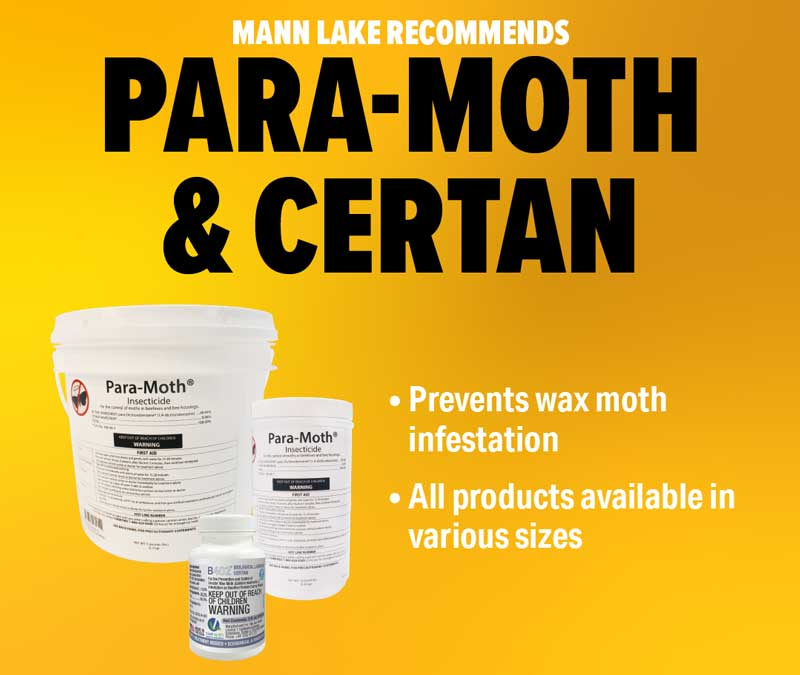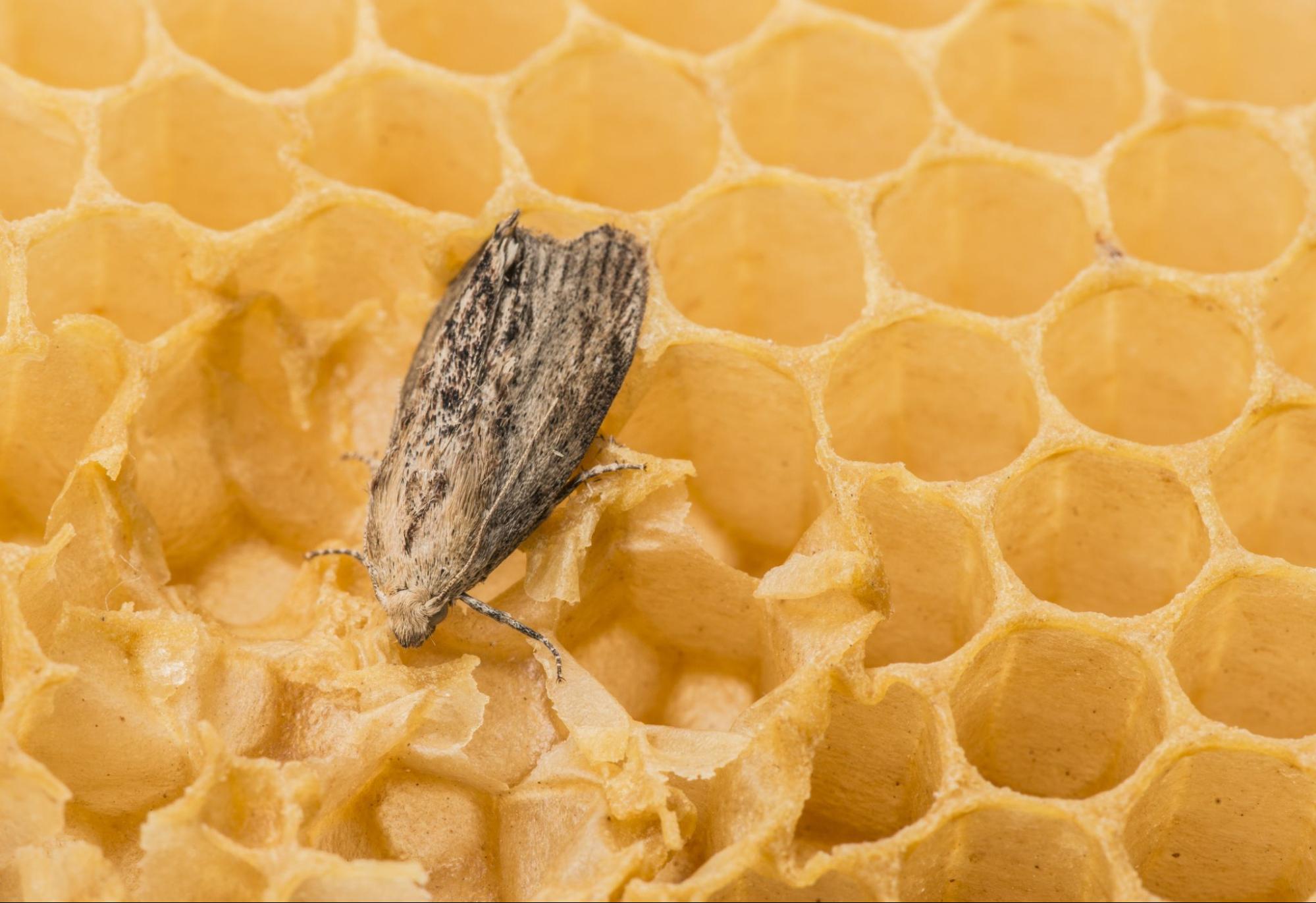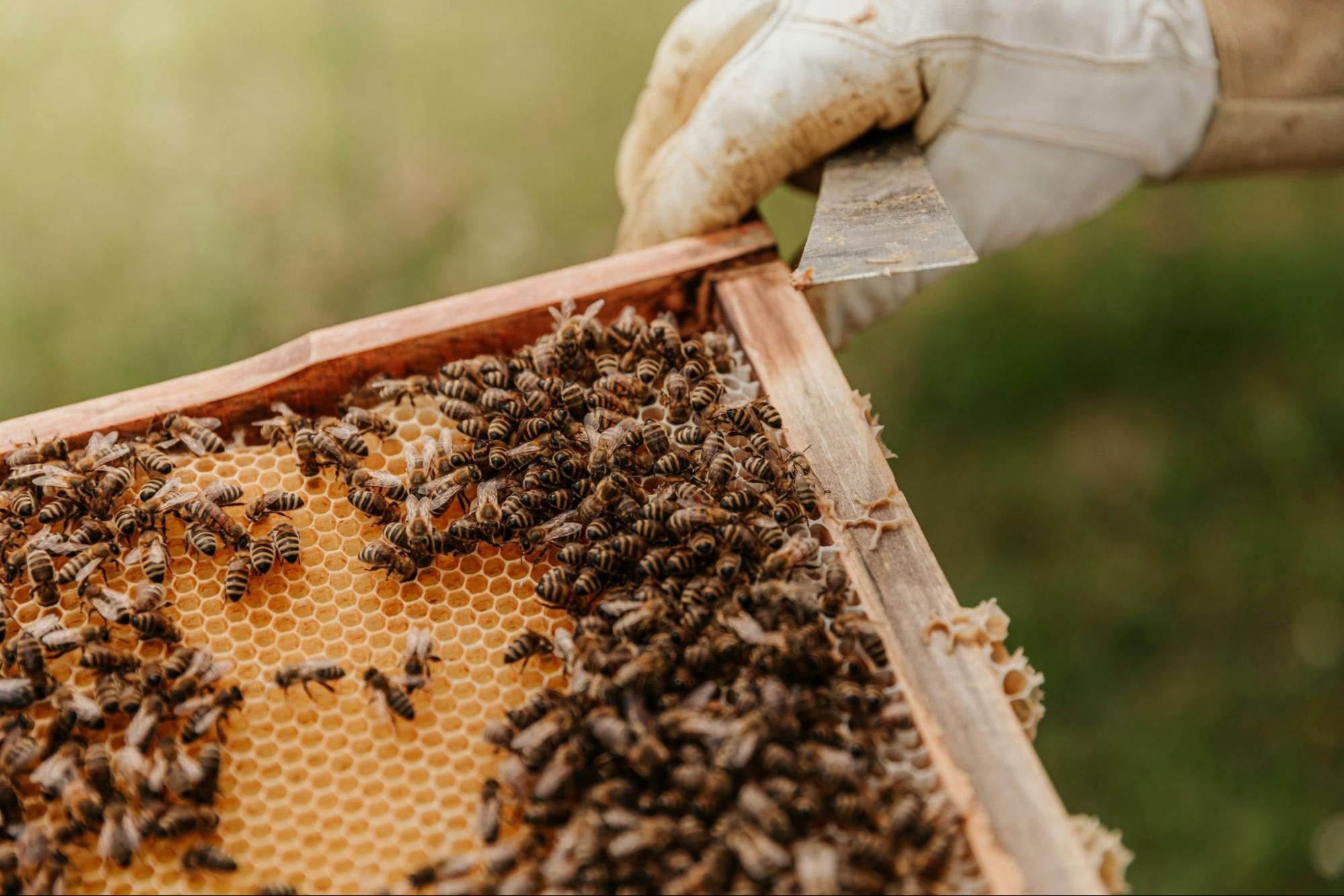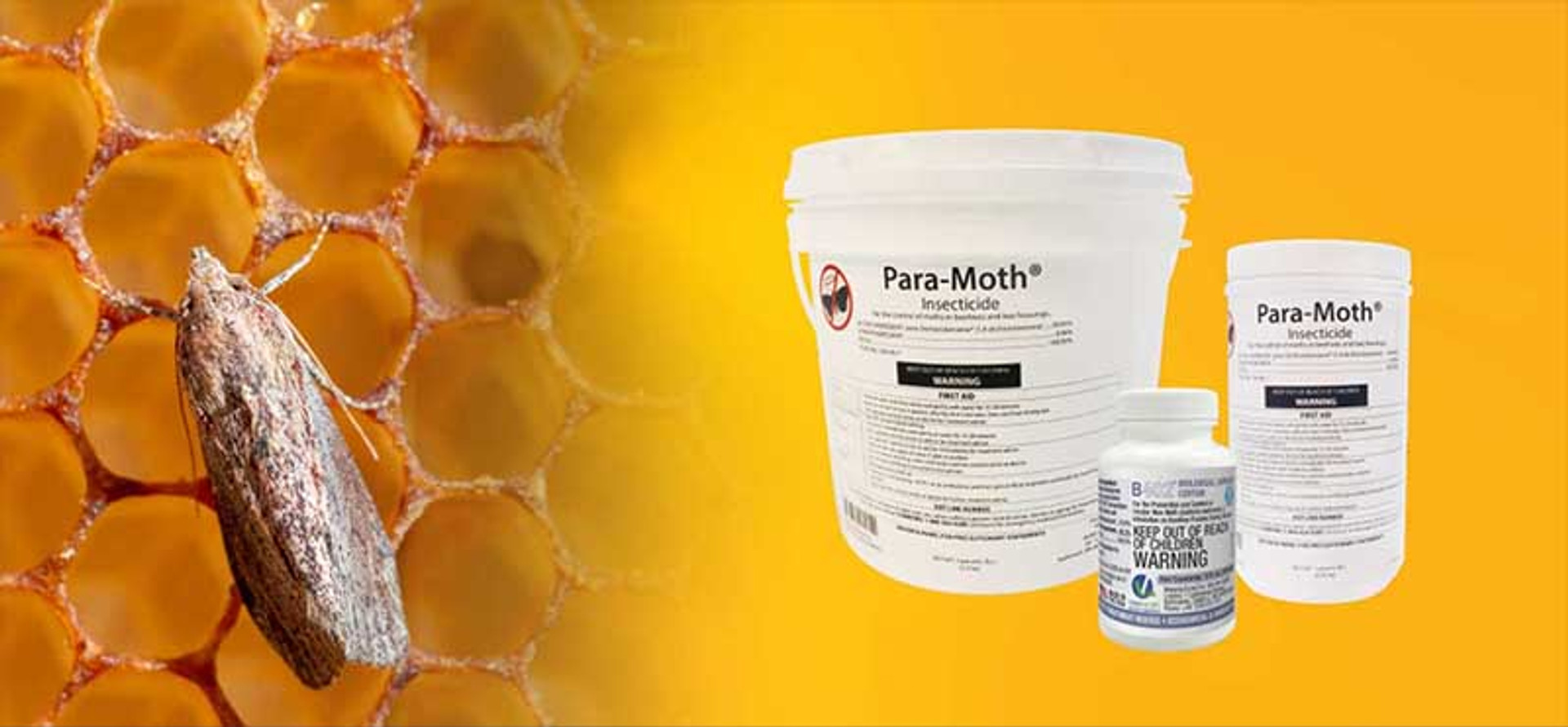Wax Moth, a Beekeeping Pest
Guide to Wax Moth Treatment and Prevention in Beekeeping
In an environment riddled with various threats to healthy beehives, it’s easy to overlook one of the most troublesome pests—the wax moths. These pests might seem harmless, but they can wreak havoc if left to roam unchecked.
That’s where preemptive and effective treatments come in. This guide provides an in-depth look at how you can prevent and treat wax moth infestations, ensuring the longevity and prosperity of your hives.
Are Wax Moths a Big Problem in Beehives?
Wax moths are a natural part of the environment. They are attracted to beehives by the scent of beeswax, honey pollen, and other hive odors. Wax moths often do not create problems in healthy honey bee colonies, but they can pose a threat in a weakened bee colony.
They destroy stored honey bee combs and cause major damage to beekeeping equipment. They’re also often blamed for the death of a honey bee colony.
How Does It Affect Beehives?
Wax moth infestations are very hazardous and can cause great damage if left unchecked for a long time. The wax moths that cause the damage in a hive may go into the beehive itself.
After the feeding is over, wax moth larvae combine to form cocoons. They eat the wooden surface of the beehive boxes to make a place for their cocoons. This weakens the beehive, and the bees get sidetracked from their usual activities.
| Maintenance Reminder: Ensure your hive's woodwork is treated with natural, bee-safe repellents to deter wax moths from laying eggs on the hive surfaces. |
How Are Wax Moths Spread?
They mainly fly at night and prefer darker areas. Hives that are unmonitored and have no access to sunlight can quickly lead to an infestation. One moth that enters a hive and lays and hatches eggs is enough to infiltrate a colony.
As these hatchlings consume comb and grow, they will quickly increase in number. They can also be spread between apiaries by the movement of infested hives. The moths will typically prefer infesting stored combs that are not actively populated by bees.
When keepers transport these combs between colonies, they can accidentally spread larvae to other hives.
How to Prevent Wax Moth Infestations
B402 Certan is an effective and economical solution to protect combs from wax moth damage. This eco-friendly product is used after the honey harvest during the storage of frames. It should be applied before any wax moth infestation occurs, as it kills young larvae.
One application provides protection for an entire season without leaving any residues in the wax or honey. A single use of this product can eliminate up to 100% of wax moth larvae, ensuring complete protection.
How to use: Simply dilute in water (1 part B402 and 19 parts water) and spray on both sides of frames prior to storage.

How to Get Rid of Wax Moth Infestations
Para-Moth is a wax moth control product that can be used by professional and beginner beekeepers. This dry crystal treatment effectively suppresses these pests and their larvae. The active ingredient, paradichlorobenzene, targets and kills both wax moths and larvae. This product should be used solely on stored supers, not on full honeycombs or live colonies.
The average treatment usage is ideally six tablespoons for every five or nine beehives. To use Para-Moth, the beehive boxes should be removed and stacked together. Then, place Para-Moth on the hive frames of the topmost beehive box in the stack. The arrangement can consist of five deep supers or nine shallow supers.
Assembled boxes should then be covered with a tarp or similar material. Equipment must be aired for several days before use.
How to use:
- Stack 5 deeps, 7 mediums, or 9 shallows full of combs on a flat surface, such as an outer cover.
- Place 2 tablespoons of the crystals on a paper plate on top, then cover tightly. The vapors will sink into the boxes.
- Allow boxes a few days to air out before placing them back on an active colony.
How to Prevent Wax Moth Growth in Stored Honey Supers
To prevent wax moth infestations in stored honey supers, freeze them for 48 hours and store them in a cool, dry place below 50°F (10°C). You can also use Para-Moth to kill larvae, ensuring you air out supers before use. Tight stacking and limiting airflow further deter wax moth growth.
Regularly inspect supers for moth activity and rotate them frequently to avoid long-term storage. These methods will help maintain the quality of your equipment and prevent wax moth damage.
Benefits of Using Wax Moth Preventatives
These products are very effective if the application is performed properly. Both Para-Moth and Certan are high-quality products that fulfill the promises they make.
They are reputable alternatives to most of the traditional methods for wax moth management. There has been no evidence of bees getting affected in any manner due to wax moth control.
Wax Moth Lifecycle Interruption Techniques
Beekeepers can enhance their defense against wax moths by employing strategies that specifically target the pest's lifecycle stages. Understanding and implementing these interventions can be a game-changer in your beekeeping practice.
The table below provides a clear overview of these effective strategies.
| Technique | Target Stage | Effectiveness | Application Tips |
| Cold Storage | Eggs, Larvae | High | Store combs at -18°C for 24 hours |
| Light Traps | Adult Moths | Moderate | Install near hives at night |
| Moth-Resistant Strains | Eggs, Larvae | Variable | Use resistant bees for comb protection |
Long-Term Impact of Wax Moths on Beehive Health
Wax moth infestations aren’t just a fleeting concern. Its effects can resonate long after the moths have been ousted. The longer wax moths inhabit a beehive, the more destruction they wreak and the more severe the long-term impacts become.
A Persistent Blow to the Bee Population
One of the most significant impacts of wax moth infestations is the depletion of the bee populations in the infested hive. The larvae, as they eat through the brood combs and honey reserves, undermine the bees’ ability to reproduce and store food. This can lead to a drastic reduction in bee populations.
Residual Damage of Wax Moths
Even when the wax moth problem is controlled, the structural damage to the beehive is typically significant. These pests damage physical structures like combs, frames, and even wooden boxes. Residual larvae and pupae can still be a challenge to weakened bee colonies even after extermination.
| Post-Infestation Action: Apply a light coat of natural, bee-safe oils on the wooden parts of your hive after cleaning. This can help repel wax moths and protect the wood from future damage. |
A Struggle to Recover
Following a wax moth invasion, the resilience of the bee colony is tested. If the infestation is caught early and treated appropriately, a colony might bounce back over time. The caveat is that the bees need to rebuild numerous components of their hive, such as honey stores and brood combs, which require substantial time and effort.
The Threat of Re-Infestation
One of the most profound, long-term concerns for beekeepers is the threat of future infestations. Once a hive body is infested, it remains an attractive site for other wax moths unless thoroughly cleaned and treated.

Recognizing Infestation Warning Signs
Identifying a wax moth infestation can help mitigate its effects and restore the health of your beehive . Here are a few key signs that your beehive may be under attack:
Webbing on Frames
Much like common house moths, wax moths leave behind a distinctive webbing or silk. If you observe unexplained, extensive webbing on wooden components or combs of the beehive, it might be a sign of wax moth activity.
Visible Holes in the Comb
Wax moths feed on beeswax, honey, and pollen, often leaving chewed-out wastelands in their wake. If you observe irregular holes, seemingly chewed through the comb, it’s a clear signal of wax moth larvae feasting.
The Presence of Larvae
Wax moth larvae resemble small, white caterpillars, often nestled among the hive. Should you spot crawling larvae in or around the beehive, immediate action is essential.
| Hive Vigilance: Increase your hive inspections during warmer months, the peak period for wax moth activity. Early detection of larvae can significantly reduce the impact on your bee colony. |
Unmasking Infestation Evidences
Examine hive bodies carefully. The destructive tendencies of these pests, especially their larvae, are unmistakable. Look out for the following evidence of infestation:
Cocoons in Corners and Cracks
Wax moth larvae spin cocoons for pupation. These brown, tough cocoons are often found in the corners, cracks, and crevices of the hive. They are typically rounded on one side and flat on the other side, resembling a peanut shell.
Galleried Honeycombs
If you find the honeycombs appearing tunnel-like or “galleried,” that’s the work of wax moth larvae. They tend to burrow through the comb, creating a maze-like pattern.
Defecation
Another telltale sign of a wax moth infestation is the presence of small, dark fecal pellets scattered about the beehive. These pellets are often referred to as “frass” and are left behind by the moth larvae.
Recognizing wax moth damage is a critical first step in combating these destructive pests. Remember, early detection is key to controlling infestations and maintaining a thriving hive. So, be vigilant, check your hives frequently, and ensure your honey bees have the best possible environment to flourish.

Frequently Asked Questions
As a beekeeper, knowing the answers to these common queries can help you stay prepared and ensure the health of your colonies. Here, we answer some commonly asked questions that will provide you with a comprehensive understanding of this persistent pest.
How do greater and lesser wax moth larvae differ?
Greater wax moth larvae cause more severe damage due to their larger size, while lesser wax moth larvae cause less, but both can harm bee hives significantly by destroying comb and honey stores.
What role do adult wax moths play in beekeeping issues?
Adult wax moths lay eggs that hatch into damaging larvae. Controlling them involves keeping strong colonies and using traps or barriers to prevent them from laying wax moth eggs.
How can you kill their larvae effectively?
Freezing infested frames and removing wax moth cocoons are effective methods to kill wax moth larvae, alongside ensuring good hive ventilation.
Can neighboring honey bee colonies affect wax moth infestations?
Yes, infestations can spread from weak or abandoned neighboring hives, highlighting the importance of monitoring and managing all nearby colonies.
What methods kill wax moth eggs efficiently?
Exposing equipment to sunlight or using specific chemical treatments can kill wax moth eggs, preventing future infestations.
What signs indicate a wax moth larvae infestation?
Webbing, tunneling in the comb, and the presence of frass indicate larvae infestation, requiring immediate action to remove affected areas and clean the hive.
How do wax moths lay eggs, and what attracts them?
Wax moths lay eggs in dark, undisturbed areas of weak hives. Proper hive management and regular inspections can deter them from laying eggs.
Final Thoughts
Having a good understanding of wax moths and the threat they pose is essential for beekeepers to stand guard to protect their hives firmly. Remember, it’s not just about safeguarding honey bees but also about skillful beekeeping.
With the right knowledge and tools at your disposal, wax moths are just another part of the beekeeping adventure.

